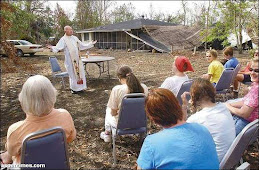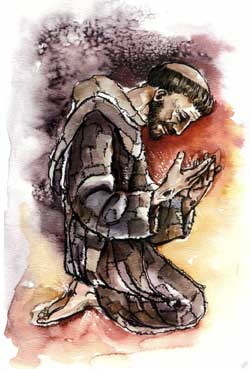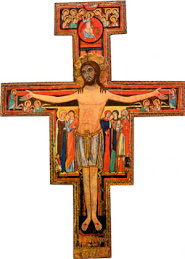Ground zero – Hurricane Katrina! What was it like for a Secular Franciscan community at ground zero? Many continue to ask about the coast of Mississippi so I am posting this account of our story - our story in the midst of one of the most devastating natural disasters in United States history. In a nutshell, it will be years before the coast of Mississippi has recovered and much has been lost forever. As a whole, we continue to suffer and have many problems. Our story below is also found on our website at http://www.ourladyofthepearl.com/.
The Story of Our Franciscan Community
and Hurricane Katrina
Written September 2006
Updated August 29, 2007
by Ouida Tomlinson, SFO
We are Our Lady of the Pearl, Pearlington, Mississippi, a Secular Franciscan community with thirteen members. We are located on the Mississippi Gulf Coast, in Hancock County. We are an emerging fraternity, seeking canonical establishment. Most of us have been very good friends for many years, but our time as a Franciscan group began in the fall of 1996. Our meeting place was the Francis House, in Pearlington. It was in the direct path of the eye of the hurricane.
Hurricane Katrina hit the Mississippi Coast as a category 3 hurricane, with sustained winds of 125 mph. Hurricane-force winds extended up to 190 miles from the center of the storm and tropical storm-force winds extended for approximately 440 miles. The Mississippi Coast was in the northeast quadrant, the most dangerous side of a hurricane. The center of the eye crossed the Mississippi-Louisiana border, near the mouth of the Pearl River, traveling north over Pearlington and Poplarville, Mississippi . The eye came directly over all of our homes, in the eighth month of 2005, on August 29th.
Massive destruction occurred across the entire Mississippi Coast. The storm surge was up to 35 feet. It penetrated at least six miles inland and up to 12 miles along bays and rivers. Numerous tornadoes compounded the hurricane’s deadly winds and water surge. People lost their lives. Millions of trees were destroyed along with wildlife, pets and domesticated animals.
Of the 171,000 homes in the coastal counties, 38% were destroyed, 22% suffered major damage, and 30% had damage. An estimated 350 buildings listed in the National Register were damaged or destroyed. Ten Catholic Churches were destroyed or gutted, ten had major damage, and four were declared unusable.
From the coast to some areas two hundred miles or more to the north, there was no electricity, water, telephone service, cell phone service, gasoline, groceries, medical or other critical services. Entire coastal communities were obliterated. All socio-economic classes and races were hit. There was no discrimination. The rich along with the poor continue to say, “We lost everything.”
OUR LADY OF THE PEARL
In Pearlington, Fr. James O’Brien said that the town suffered destruction of atomic proportions. It became a wasteland of frightened, homeless people and broken hearts. St. Joseph Catholic Church was leveled with only the steps remaining. The meeting place of Our Lady of the Pearl, the Francis House, was left with only the slab, and all contents gone. Everything was swept clean and disappeared.
In the midst of this tragedy, Our Lady of the Pearl members held together as a family. Within a day or so after the hurricane, we began looking for each other. Initially, the primary difficulty was that none of us were at our usual places. All of us evacuated, either before or after Katrina. Also, telephones, cell phones and the internet were not working well or at all. This loss of communication was one of the scariest parts.
Gradually, over those early days, we were able to verify that all members were alive, and we spread news about each other through the crippled lines of communication. Slowly other news – sad news - also was confirmed about our members, our families and the way of life we had lost.
Some members of Our Lady of the Pearl lost their homes and all possessions; most of the remaining ones suffered extensive damage to home and property and losses of all or most of their possessions. Anything that was left, was covered with mold. Many of our adult children suffered the same type of losses.
Nature also suffered. We lost beautiful trees, shrubs, flowers and grass. The land was stripped bare, and the ground was covered with a tarry, black yuck, left by the flooding. At times we seemed to hear the trees crying and all nature sobbing, joining us in our tears and sorrows.
We often said we didn’t know where we belonged anymore except with each other and that everything had changed. We stayed in contact, especially as telephones, cell phones and internet services returned. During the early weeks and months after Katrina, two, three or more came together regularly and sometimes weekly. We had the Transitus of St. Francis in October, and some met in Natchez for retreats.
A year after Katrina most of those of Our Lady of the Pearl with standing homes still had much repair work to be done. Some homes continued to be unlivable. Much delay has been caused by insurance settlement problems, being under insured or not being able to find contractors and laborers to do the work.
There have been tremendous financial losses among us, and only a couple of us have been made whole by insurance proceeds or other sources. The standard of living has declined greatly for some. A few members who had retirement funds or savings have dug deeply into these resources to have livable homes. Others had no savings. Some have lost their businesses or jobs.
All of us have suffered and continue to suffer from episodes or periods of what has become referred to as post-Katrina stress syndrome. This includes an inability to concentrate, low energy, exhaustion, depression, grief, confusion, inability to remember, anxiety, anger, and sadness. The list goes on. The stress also has brought on physical problems such as chest pains, heart problems, weight loss or gain, headaches and other symptoms.
OUR MEMBERS ENCOUNTER KATRINA
Hedy, her husband, and family stayed in Pearlington during the hurricane, on the top floor of their raised home. It overlooked the Pearl River , and the water rose approximately 30 feet or more, filling the lower part of the house. It was gutted and destroyed by the wind and flood waters, which took away all of the contents.
Ann and her husband also lived in Pearlington. The interior of their home had water to the ceiling, causing extensive damage. They too lost furniture, furnishings, clothing and other personal property. They lost over 600 trees. One year after Katrina, repair on their home was almost finished.
Eileen and Renee were neighbors in Bay St. Louis, Mississippi, about 17 miles further east of Pearlington. They lived across the street from the Bay of St. Louis . Both families lost their homes and all contents, with nothing left except the frame or slab.
Bobbye also lived in Bay St. Louis, within a couple of blocks of the Gulf. Her home is on a ridge, at an elevation higher than most. She and her husband stayed for Katrina. Their home was flooded with about three feet of water. Contents on the first floor had to be thrown away. The flooding and the mold required extensive cleaning and renovations, which were incomplete one year after Katrina.
Tom and Ouida live in Diamondhead , Mississippi , situated north of the Bay of St. Louis and about 22 miles east of Pearlington. They had only minor roof damage and several trees down, but less than one mile from them, homes were gutted by tornadoes or the storm surge. Less than two miles away, homes and businesses were obliterated, with nothing left.
Bob and Patty stayed for Katrina at their home in Poplarville, north of the coast and approximately 60 miles from Pearlington. They had extensive damage to their three-story home. It was hit by a tornado which sucked out a sky light. Water flooded the house, causing much damage and losses to the structure and contents. They evacuated and returned a month later to find everything covered with mold. It took almost one year to restore their home.
John and Carol lived in Slidell, Louisiana, near Lake Ponchatrain and approximately 15 miles west of Pearlington. Their home in Slidell received about four feet of water with extensive damages and losses and is not livable without massive repairs. They are living in a FEMA trailer in Poplarville , Mississippi .
Karen lives in Pearl River, Louisiana, near Slidell and about 20 miles from Pearlington. Over half the roof of her home in Pearl River had structure damage from the eight trees falling on it, but the house was livable. There were 46 trees down on their one acre plus lot.
Debbie lives further west, in Mandeville, Louisiana, north of Lake Ponchatrain and New Orleans and about 40 miles from Pearlington. Her home also had damage.
OUR FIRST COMMUNITY GATHERING AFTER KATRINA
On November 5, 2005, Ann, who had relocated to Slidell, Louisiana, was able to offer the hospitality of her home for our first post-Katrina community meeting, and we have met every month since. This November gathering was one that we shall never forget. We were still in shock as to all that had happened.
We read St. Francis’ description of true joy that he gave to Brother Leo. In all that we were experiencing in our lives, what we needed most was patience and joy. St. Francis’ words went straight to our hearts. We said that to experience the very worst that can happen to us with patience is to experience true joy.
Our discussions that day covered many subjects such as how were we to respond as Christians and Franciscans and what did God expect of us in the midst of Katrina’s devastation. We reminded ourselves that God requires two things of us: to love our Lord our God with all our heart and second, to love our neighbors as ourselves.
We asked why we had to suffer. We asked if this was a purification, such as was experienced by God’s people in the Old Testament when they fell away from him, then why did we, God’s faithful children, have to suffer and lose so much? Part of the answer seems to be that we must live along side others who are Katrina victims to be God’s presence. We are serving him in our suffering. We had to be here, in this place, at this time, when Katrina came
.
We came away that day with the knowledge that we had been stripped of all things, but as Christ’s followers, in the footsteps of St. Francis, we knew that God loves us and would never hurt us and that he wants us to find our peace, love and joy in Him. We realized that these are the truths that we must take to all people in our lives and that by our example, we must bring the peace of our Lord, as spoken of by St. Francis.
During the year following Hurricane Katrina, Our Lady of the Pearl learned much from our experiences. We have a deeper insight into human suffering and a greater sympathy with its victims. We have learned that things and stuff are not so important. There is a greater desire to simplify our lives. Our priorities have changed. The importance of God, family and loved ones is very clear, and there is an enhanced appreciation for spouses. We have learned, over and over, that God loves us.
We are so grateful to be Franciscans as it has prepared us spiritually for these times. Also, we are so grateful for our community. It has provided a safe and supportive place in our post-Katrina world, a place to emotionally share our stories, grief and trauma at the deepest levels. A year after Katrina, one member aptly described our feelings: “I thank all of you for being there for me during this past year. You all are so important in my life - my stability during our most unstable time. I love you all.”
It is August 29, 2007, two years since Hurricane Katrina. Many on the Mississippi Gulf Coast continue to struggle with making repairs to homes and businesses and struggle with insurance companies who have denied their claims. Recovery is blocked in many ways because business owners and home owners cannot afford or obtain insurance. Would-be home owners do not purchase homes for the same reasons.
We hear complaints from others that we should not live in hurricane areas and flood zones. They fail to understand that the storm surge (up to 35 feet in some areas) which followed and accompanied Katrina went into areas not classified as flood zones. Many did not have flood insurance because they do not live in flood zones. At the same time, weather related disasters are occurring all over the country so all in the United States are vulnerable to the weather no matter where we live.
Members of Our Lady of the Pearl Secular Franciscan community are at different stages of recovery from Katrina. Eileen, Hedy, and Renee lost their homes. Hedy moved to Natchez but hopes to rebuild in Pearlington. Eileen and Renee have purchased new homes. Most of the repairs have been completed at Bobbye’s, and John and Carol are working on their home repairs but still in a FEMA trailer.
The homes for the rest of us have been repaired. Ann is home again in Pearlington. Our community now meets in her guest house since the Francis House was lost in Katrina. St. Joseph Catholic Church was destroyed in Pearlington and will not be rebuilt. Only the steps are remaining, one of the many reminders of what has been lost forever along with the destruction to nature.
We miss our trees - young trees - centuries-old trees. We miss our grocery stores (only two in our county now), our doctors who have left, our friends who have moved away, our beautiful coastline, our way of life, our churches which were destroyed, our public services, public buildings, the antebellum homes, our stability (economic, emotional, and otherwise), schools, and on and on. The poor especially suffer in such areas as housing. Costs have soared, and there is little affordable housing for the poor and lower middle class. We miss the greater security we had from a lower crime rate. We miss - we miss. But the God of All Comfort is here, and in his presence, the things of earth grow strangely dim.
- "God has created me to do Him some definite service; He has committed some work to me which He has not committed to another. I have my mission—I never may know it in this life, but I shall be told it in the next. Somehow I am necessary for His purposes, as necessary in my place as an Archangel in his—if, indeed, I fail, He can raise another, as He could make the stones children of Abraham. Yet I have a part in this great work; I am a link in a chain, a bond of connection between persons. He has not created me for naught. I shall do good, I shall do His work; I shall be an angel of peace, a preacher of truth in my own place, while not intending it, if I do but keep His commandments and serve Him in my calling."
- Therefore I will trust Him. Whatever, wherever I am, I can never be thrown away. If I am in sickness, my sickness may serve Him; in perplexity, my perplexity may serve Him; if I am in sorrow, my sorrow may serve Him. My sickness, or perplexity, or sorrow may be necessary causes of some great end, which is quite beyond us. He does nothing in vain; He may prolong my life, He may shorten it; He knows what He is about. He may take away my friends, He may throw me among strangers, He may make me feel desolate, make my spirits sink, hide the future from me—still He knows what He is about. " Source: John Henry Newman


















No comments:
Post a Comment